The banjo is a stringed instrument with a thin membrane stretched over a frame or cavity to form a resonator. The membrane is typically circular, in modern forms usually made of plastic, originally of animal skin. Early forms of the instrument were fashioned by African Americans and had African antecedents. In the 19th century, interest in the instrument was spread across the United States and United Kingdom by traveling shows of the 19th century minstrel show fad, followed by mass-production and mail-order sales, including instruction method books. The inexpensive or home-made banjo remained part of rural folk culture, but 5-string and 4-string banjos also became popular for home parlour music entertainment, college music clubs, and early 20th century jazz bands. By the early 21st century, the banjo was most frequently associated with folk, bluegrass and country music, but was also used in some rock, pop and even hip-hop music. Among rock bands, the Eagles, Led Zeppelin, and the Grateful Dead have used the five-string banjo in some of their songs.
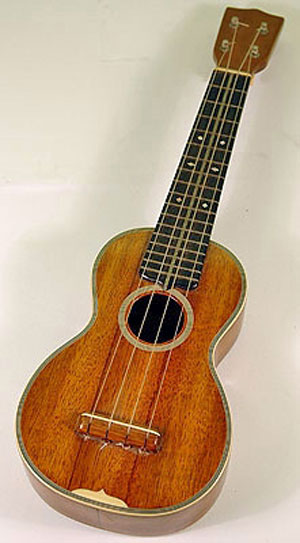
The ukulele, also called a uke, is a member of the lute family of instruments of Portuguese origin and popularized in Hawaii. It generally employs four nylon strings.
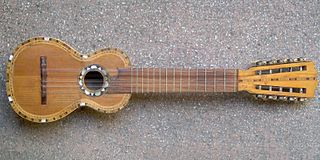
The charango is a small Andean stringed instrument of the lute family, from the Quechua and Aymara populations in the territory of the Altiplano in post-Colonial times, after European stringed instruments were introduced by the Spanish during colonialization. The instrument is widespread throughout the Andean regions of Bolivia, Peru, Ecuador, northern Chile and northwestern Argentina, where it is a popular musical instrument that exists in many variant forms.
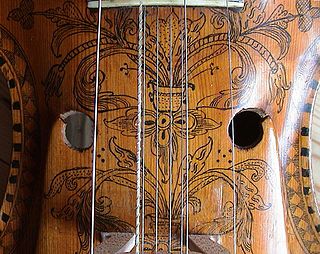
Sympathetic strings or resonance strings are auxiliary strings found on many Indian musical instruments, as well as some Western Baroque instruments and a variety of folk instruments. They are typically not played directly by the performer, only indirectly through the tones that are played on the main strings, based on the principle of sympathetic resonance. The resonance is most often heard when the fundamental frequency of the string is in unison or an octave lower or higher than the catalyst note, although it can occur for other intervals, such as a fifth, with less effect.

The banjo ukulele, also known as the banjolele or banjo uke, is a four-stringed musical instrument with a small banjo-type body and a fretted ukulele neck. The earliest known banjoleles were built by John A. Bolander and by Alvin D. Keech, both in 1917.
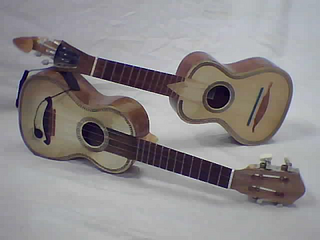
The cavaquinho is a small Portuguese string instrument in the European guitar family, with four wires or gut strings.

A tiple, is a plucked typically 12-string chordophone of the guitar family. A tiple player is called a tiplista. The first mention of the tiple comes from musicologist Pablo Minguet e Irol in 1752. Although many variations of the instrument exist, the tiple is mostly associated with Colombia, and is considered the national instrument. The Puerto Rican version characteristically has fewer strings, as do variants from Cuba, Mallorca, and elsewhere among countries of Hispanic origin.
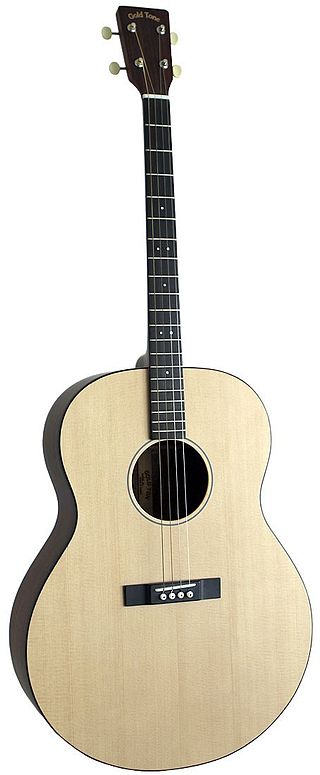
The tenor guitar or four-string guitar is a slightly smaller, four-string relative of the steel-string acoustic guitar or electric guitar. The instrument was initially developed in its acoustic form by Gibson and C.F. Martin so that players of the four-string tenor banjo could double on guitar.

A course, on a stringed musical instrument, is either one string or two or more adjacent strings that are closely spaced relative to the other strings, and typically played as a single string. The strings in each multiple-string course are typically tuned in unison or an octave.

The name chillador can refer either to two related types of charango. The First type, simple called chillador is a type of charango which has a flat back and is usually steel-strung. It exists in both 10-and 12-string forms. When strung with 10-strings it is tuned the same as a charango. With 12 strings, courses 2 and 4 are triple-strung, and the (re-entrant) tuning is more like that of a charangon or ronroco in Argentine tuning. The chillador charango is a standardly-tuned charango but with a body built from bent sides and a flat back like a (smaller) guitar,
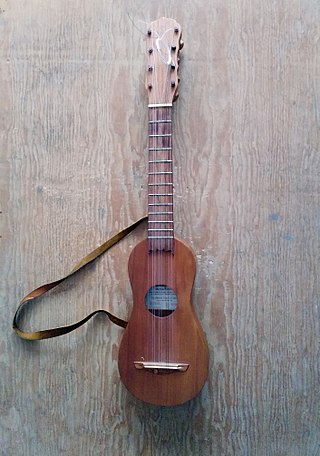
The jarana jarocha is a guitar-shaped fretted stringed instrument from the southern region of the state of Veracruz, Mexico. Typically strung with 8 strings in 5 courses, usually arranged in two single outer strings with three double-courses in between. The strings are usually nylon, although they were gut in the past. The body is somewhat narrower than a guitar because of its direct lineage from the Spanish baroque guitar of the sixteenth century. Sometimes mistaken for a ukulele, the jarana jarocha comes in at least five sizes, the smallest being the chaquiste, somewhat smaller than a soprano ukulele; then the mosquito, about the size of a soprano ukulele; the 'primera', about the size of a concert ukulele; the 'segunda', in length between a tenor and a baritone ukulele; and the 'tercera', somewhat longer than the baritone ukulele. Some luthiers are building jaranas of a size they label "tercerola" or "jarana cuarta", but there is some discussion as to whether these represent a distinct size or are merely particularly large variations of the standard tercera.
The cuatro is a family of Latin American string instruments played in Puerto Rico, Venezuela and other Latin American countries. It is derived from the Spanish guitar. Although some have viola-like shapes, most cuatros resemble a small to mid-sized classical guitar. In Puerto Rico and Venezuela, the cuatro is an ensemble instrument for secular and religious music, and is played at parties and traditional gatherings.
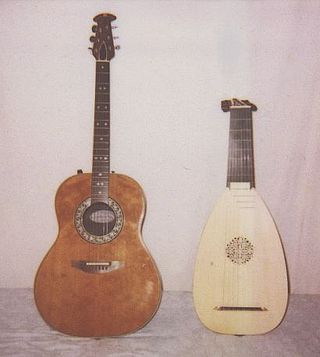
Plucked string instruments are a subcategory of string instruments that are played by plucking the strings. Plucking is a way of pulling and releasing the string in such a way as to give it an impulse that causes the string to vibrate. Plucking can be done with either a finger or a plectrum.

There are many varieties of ten-string guitar, including:
This is a chart of stringed instrument tunings. Instruments are listed alphabetically by their most commonly known name.
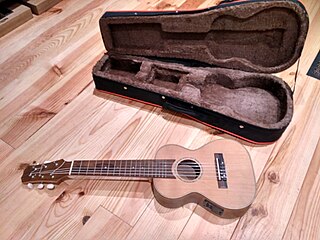
A guitalele, also called a ukitar, or kīkū, is a guitar-ukulele hybrid, that is, "a 1/4 size" guitar, a cross between a classical guitar and a tenor or baritone ukulele. The guitalele combines the portability of a ukulele, due to its small size, with the six single strings and resultant chord possibilities of a classical guitar. It may include a built-in microphone that permits playing the guitalele either as an acoustic guitar or connected to an amplifier. The guitalele is variously marketed as a travel guitar or children's guitar. It is essentially a modern iteration of the Quint guitar.

The cuatro of Venezuela has four single nylon strings, tuned (ad'f#'b). It is similar in shape and tuning to the ukulele, but their character and playing technique are vastly different. It is tuned in a similar fashion to the traditional D tuning of the ukulele, but the A and B are an octave lower. Consequently, the same fingering can be used to shape the chords, but it produces a different inversion of each chord. A cuatro player is called a cuatrista.

The Colombian tiple, is a plucked string instrument of the guitar family, common in Colombia where it is considered one of the national instruments. About three-fourths the size of a classical guitar, it has twelve strings set in four triple-strung courses. It is played as a main instrument or as an accompanying instrument to the guitar.




















